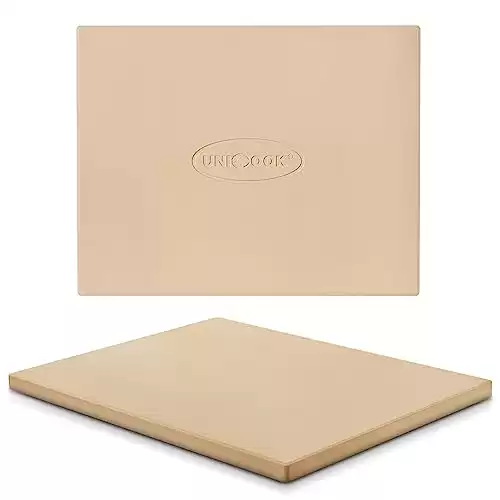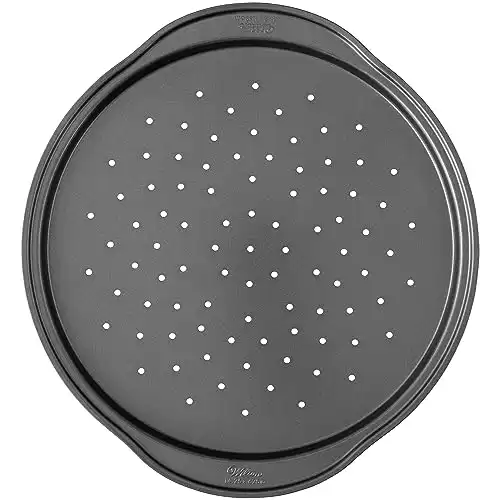Are you looking for the best way to bake pizza at home? Using the right tool will make or break your pizza. Get ready for the ultimate baking tool battle: pizza stone vs pizza pan.
In this article, we’re going to go deep and compare pizza stones and pizza pans so you know which tool will make the best homemade pizza. Stay tuned!
What is good pizza?
The secret to great pizza is the crust. The type of dough and the way you bake your pizza are critical to your success. That’s why using a pizza stone or a pan matters.
To get a good crust, you need to start with a good dough. Quality ingredients, proper kneading, and slow fermentation will result in great consistency and flavor. If you need a recipe, click here.
But maybe even more important than the dough is the way you bake your pizza. For the best possible result, you should bake your pizza hot and fast. Like in a
Baking your pizza at a high temperature will make the rim puff up, and create a crust that’s airy and soft on the inside, while charred and crunchy on the outside. Not, dense and bready, like homemade pizzas often are. So to make great pizza, you need to bake it quickly in a hot oven.
Does a pizza stone or a pizza pan make better pizza?
The short answer is that a pizza stone makes a better pizza because provides a baking surface similar to a
Both pizza stones and pans do however have their advantages and drawbacks. And one may fit you better than the other. So let’s go over each of them in detail.
What is a pizza stone?
A pizza stone is a baking surface made from ceramic, cordierite, or clay that you preheat in your oven to simulate the hot floor of a
By preheating your pizza stone, retinas heat, which will help the bake the bottom of your pizza faster, just like a
To get the full potential, a pizza stone must be preheated for at least 1 hour at 500°F (260°C), or at the hottest setting, before baking. The pizza must also be baked directly on the surface of the stone, not on parchment paper (which might burn in a hot oven).
Pros of a pizza stone
The main benefits of a pizza stone:
- Bake pizza hotter and faster
- Dry out the bottom of the pizza to make it crispier
- Charrs bottom due to the heat
- Gives the pizza more oven spring
Bakes your pizza like a pizza oven
One of the problems with baking pizza at home is that it often takes longer to bake the bottom of the pizza than the top. And this problem gets worse the hotter you try to bake your pizza.
So the major benefit of pizza stone is that it heats up and creates that hot surface that will balance baking, and ensure a crispy result. When you heat up your pizza stone, it will hold on to heat, so when you bake your pizza directly on the stone, it will start baking immediately. And the extra heat the stone retains will speed up the baking process.
A pizza stone is also porous, which makes it absorb moisture from the pizza dough to bake it even faster. The dough doesn’t crisp before the moisture is drawn out from the surface of the dough. So this, combined with the extra heat the stone holds on to will also create a char on the pizza, just like in a real
Gives your pizza a lighter, airier crust
But one of the best things about a pizza stone is that when you place the pizza directly on the hot surface, it will give the rim of your
Cons of a pizza stone
The main drawbacks of a pizza stone:
- Requires practice
- Absorbs moisture and fat that spills on the stone
- Hard to clean
- Some pizza stones are prone to cracking
- Requires extra equipment
It requires practice to master your pizza stone
The main challenge with a pizza stone is the steep learning curve. It requires some practice to fully master your pizza stone. You have to know your oven and experiment with pre-heating times and temperatures to find the right balance. But you also need to practice moving your pizza using a
The stone absorbs spilled moisture and fats
If cheese, sauce, or anything else drips down on the blazing hot stone during baking, the pores of the stone will absorb this moisture, just like moisture from the dough. This can create smoke in your oven and bad flavors to your pizza.
It’s hard to clean a pizza stone
A pizza stone is also hard to clean. It absorbs moisture that’s hard to get rid of, and the hot temperature also burns anything that spills on the stone during baking.
Cleaning is necessary after baking, but if you bake multiple pizzas and spill something on the first bake it can ruin pizza night!
A pizza stone brush will help you clean the stone between pizzas. But after baking, you need to let the stone cool completely (this usually takes at least 1-2 hours) and clean it using water and a brush. You should however never use soap, detergent, or any other chemicals because these will also be absorbed by the stone and flavor your pizza!
Certain materials are prone to cracking
Some types of pizza stones also crack easily (it took me a couple of cracked stones to realize this!). Thin ceramic and clay stones are particularly prone to cracking. This mostly happens due to thermal shock, but you can read more about pizza stone materials here.
Requires extra tools
The last drawback of a pizza stone is that it requires some extra tools. To get the most out of your pizza stone, you need a
Another recommended accessory to your pizza stone is an infrared thermometer to check the temperature of your stone. It’s not essential but will be helpful for consistent baking.
The best pizza stone for perfect pizza at home
The best pizza stone is a thick, cordierite stone. Cordierite is a strong, thermal shock-resistant material that will not easily crack. And a thicker stone will be able to hold onto more heat than a thinner stone.
A great choice is the Unicook Pizza Stone Heavey Duty Cordierite Pizza Dsonte. This is a thick, heavy-duty pizza stone with even heat distribution. It’s made from cordierite and can handle temperatures up to 1450°F (787°F). The perfect choice if you want crispy pizza at home!
The Unicook Pizza Stone, crafted from durable, odorless Cordierite and capable of withstanding up to 1,450°F, ensures even heat distribution for perfectly crispy crusts. This pizza stone is a must-have for any pizza enthusiast.
What is a pizza pan?
A pizza pan is a metal sheet you bake your pizza in.
Unlike pizza stones, there are many types of pizza pans. Different materials shapes and sizes. Most pizza pans are made from aluminum or steel. The 2 main types of pizza pans are perforated and non-perforated pizza pens.
A perforated pizza Pan is simply a Pan filled with small holes. These holes help steam escape and help the dough crisp.
Pros of a pizza pan
The benefits of a pizza pan are:
- Easy to use
- Easy to clean
- Cheap
A pizza pan is easy to use! All you need to do is stretch out the dough and place it in the pan. You can even stretch it inside the pan to help you make a round, even pizza. Then, top your pizza with your favorite sauce cheese, and toppings.
A pizza pan is also easy to clean. Many pizza pans have non-stick surfaces, so stains and residue are easy to remove. You can even put some pizza pans in the dishwasher.
Pizza pans are also cheap and can be found as low as 5 dollars, but a good pan usually costs 10 – 30 dollars.
Cons of a pizza pan
The drawbacks of a pizza pan are:
- Takes longer to heat and bake pizza
- non-perforated pans trap steam and prevent crisping
- Dough sinks into holes in perforated pans
The main drawback of a pizza pan is that it starts cold in the oven. Because you prepare your pizza inside the pan, you can’t pre-heat it. This means it will take some time for the pan to reach baking temperature and start baking the pizza. Something that will result in less oven spring and therefore a more dense crust. The total baking time is also longer, something that makes it harder to make crispy pizza.
The problem with a non-perforated pan, like an oven sheet, is that it traps steam under the dough. So the combination of long heating time and the pan traps steam when it finally reaches baking temperature, making it take much longer to bake the bottom of the pizza and much harder to make it crispy.
A perforated pizza pen tries to combat this by adding holes. The holes help steam escape, and this speeds up the baking process and makes crispier pizza. But it still takes some time for the pan to reach baking temperature. so it’s not perfect.
A challenge with a perforated pan is that the dough may sink into the holes and get stuck. This is particularly common if you have a thicker dough or a heavy pizza due to many toppings.
The best pizza pan
The best type of pizza pan is a perforated steel pan. This will get hot and bake the pizza, and the holes will let the steam out, and give you a crispy pizza.
A quality, dishwasher-safe perforated pizza pan for easy pizza baking.
Comparison: pizza stone vs pizza pan
Both pizza stones and pens have benefits and drawbacks. So which one suits you better depends on your goal and pizza baking level.
A pizza pan is a cheap beginner-friendly tool. It’s easy to use, easy to clean, and makes good pizza when you pick the right pan.
A pizza stone makes a better pizza. Even though the learning curve is steeper and it requires a little bit of practice to get it right, you can make amazing pizza with a pizza stone. It bakes pizza faster and hotter, resulting in a crispy crust, and lighter airy dough and it’s the closest you get to a Neapolitan oven in your own kitchen!
Related
- Ooni Turning Peel Review: The Best Peel for Home - April 15, 2024
- Gi.Metal Turning Peel Review: Is This the Ultimate Pizza Tool? - April 14, 2024
- Discover Pizza Mastunicola: The Story of the First Pizza - April 7, 2024



